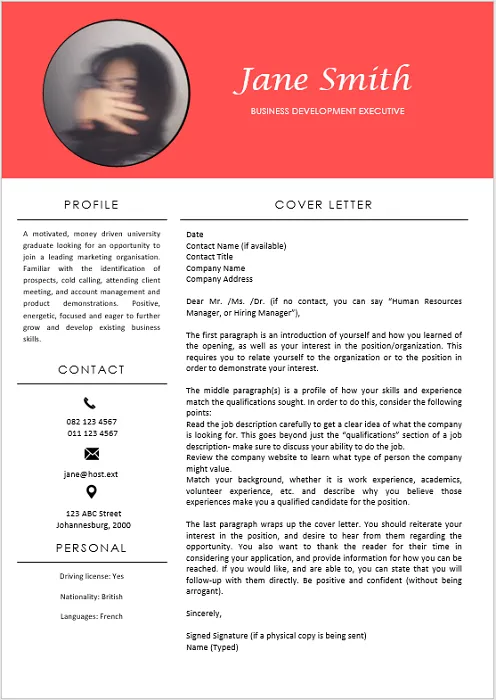Cover Letter for Business Development Executive What You Need
A well-crafted cover letter is your first chance to make a positive impression and demonstrate why you are the ideal candidate for a Business Development Executive position. Unlike a resume, a cover letter allows you to showcase your personality, communication skills, and passion for the role. It should not simply reiterate the information found in your resume; instead, it should provide a compelling narrative that highlights your relevant experience, skills, and achievements, while expressing your enthusiasm for the specific company and position. A strong cover letter can significantly increase your chances of getting an interview and ultimately landing your dream job. This guide will walk you through the essential elements of crafting a standout cover letter that effectively communicates your qualifications and sets you apart from other applicants. Remember, each cover letter should be tailored to the specific job and company to maximize its impact.
Understanding the Business Development Executive Role
Before you start writing your cover letter, it is important to understand the core responsibilities of a Business Development Executive. This role typically involves identifying and pursuing new business opportunities, building and maintaining client relationships, and driving revenue growth. Business Development Executives often work to create and implement strategies to expand the company’s market presence and increase profitability. They need a blend of sales, marketing, and strategic thinking skills to be successful. This position requires a proactive approach, strong negotiation abilities, and a keen understanding of the market landscape. Understanding the intricacies of the role is crucial for tailoring your cover letter to highlight the specific skills and experiences that align with the employer’s needs. Showing that you understand the job and the company’s goals, such as growth and expansion, will make your cover letter more effective.
Key Responsibilities of a Business Development Executive
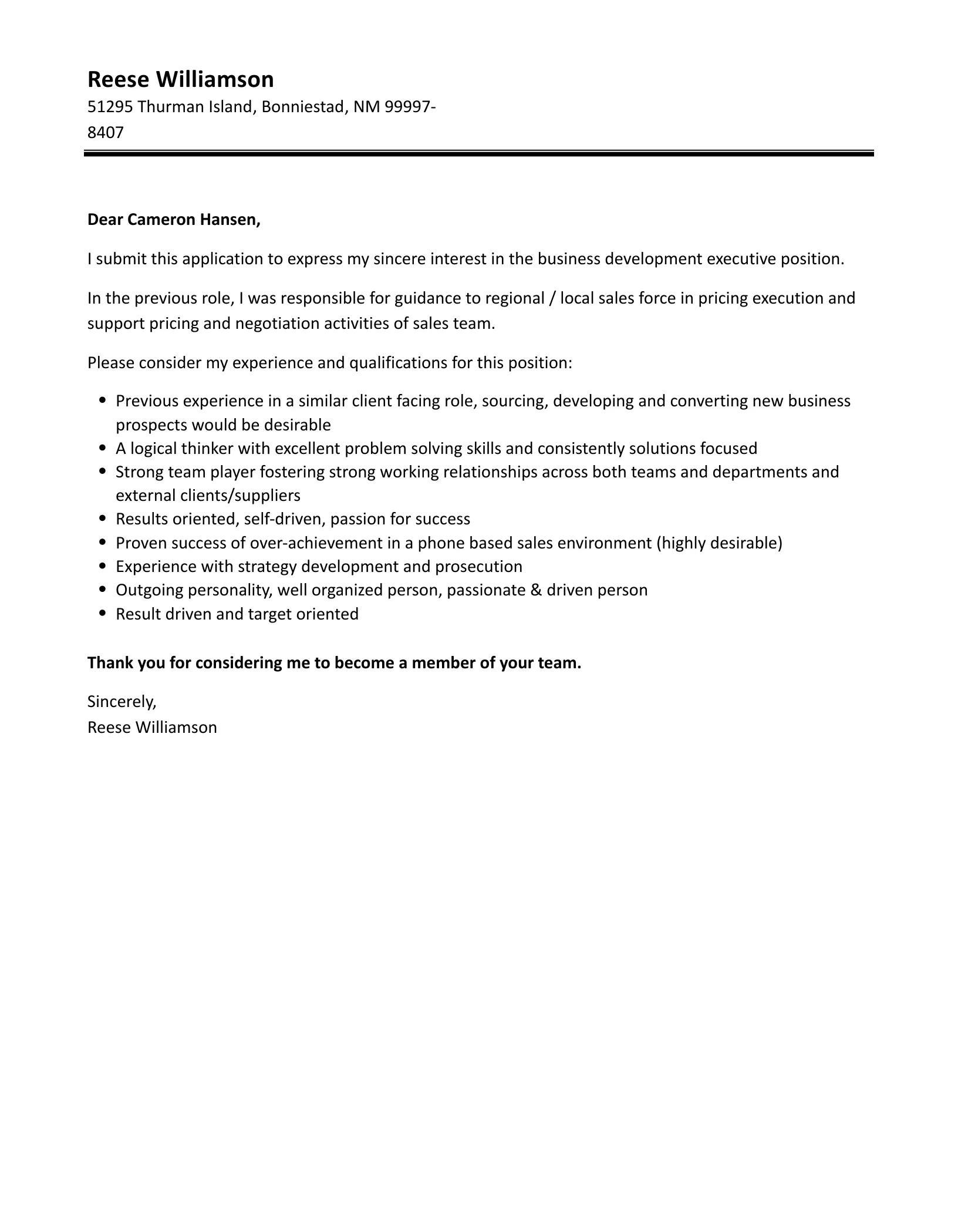
Business Development Executives wear many hats, with responsibilities that can vary depending on the company and industry. Typical duties often include lead generation, prospecting potential clients, developing and executing business development strategies, and managing sales pipelines. They are also responsible for building and maintaining relationships with key clients, negotiating contracts, and closing deals. Furthermore, these professionals are often involved in market research, competitive analysis, and identifying new business opportunities. These tasks involve staying informed about industry trends, understanding customer needs, and adapting strategies to meet changing market demands. By knowing these responsibilities, you can align your past experiences with the requirements of the job, and use relevant keywords and examples in your cover letter.
Researching the Company Before Writing
A key part of writing a successful cover letter is researching the company. This preparation will show you are interested in the position and can help you tailor your letter effectively. Visit the company’s website, read their ‘About Us’ section, and review any recent press releases or news articles. Look at their mission statement, values, and recent achievements. Understand their products or services, target market, and competitive landscape. Also, find information on the hiring manager if possible. Knowing who will read your letter enables you to personalize your cover letter to that person. This research provides insights that you can use to demonstrate your knowledge of the company and your understanding of their needs. Referencing specific company initiatives or values will make your cover letter more relevant and engaging. Highlighting how your skills and experience align with their goals is a great way to grab their attention and increase your chances of getting an interview.
Tailoring Your Cover Letter
Generic cover letters are easily identifiable and often end up in the rejection pile. Tailoring your cover letter to each specific job is essential. Do not rely on a one-size-fits-all approach. Carefully review the job description and identify the key skills, experiences, and qualifications that the employer is seeking. Customize your cover letter to address these specific requirements. Use the same keywords and phrases that are used in the job description to help it pass through Applicant Tracking Systems (ATS). In your cover letter, provide specific examples of how you have demonstrated these skills and achieved results in previous roles. Show the hiring manager that you have a clear understanding of their needs and that you are a great fit for their company. Personalize your cover letter by mentioning the company’s name and showing that you have researched their business, values, and goals.
Highlighting Relevant Skills
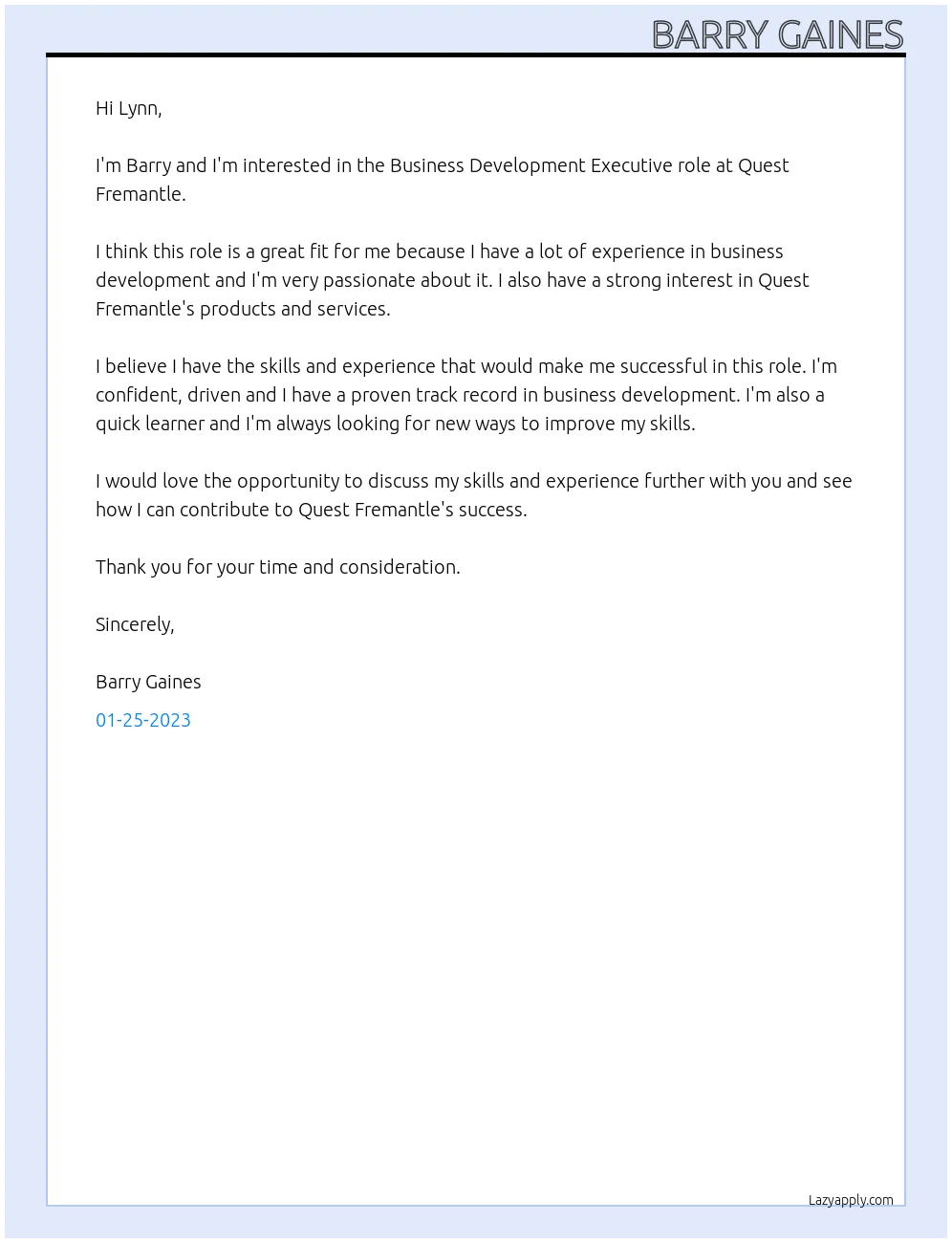
The most effective cover letters focus on the most relevant skills for the Business Development Executive role. Highlight your abilities related to sales, marketing, negotiation, and relationship management. Provide specific examples of how you have used these skills to achieve positive results in your previous positions. Emphasize your experience in lead generation, prospecting, and closing deals. Show your ability to develop and execute successful business development strategies. Moreover, showcase your communication, presentation, and interpersonal skills. Demonstrate your ability to build rapport with clients and negotiate contracts. The goal is to provide the hiring manager with a clear and compelling picture of your abilities. This section is all about ensuring the skills highlighted in the job description are also highlighted in the cover letter. Providing evidence and results will convince them that you possess these skills.
Showcasing Business Acumen
A Business Development Executive needs a solid understanding of business principles, market dynamics, and the competitive landscape. In your cover letter, showcase your business acumen by demonstrating your ability to analyze market trends, identify opportunities, and develop effective strategies. Include examples of how you have used your understanding of business principles to drive revenue growth, increase market share, or improve profitability. Illustrate your ability to think strategically and make sound business decisions. Mention any experience with financial analysis, budgeting, or forecasting. The hiring manager is looking for someone who can see the big picture, understand the market, and drive results. Providing examples of successful business development initiatives and how you contributed will create a good impression.
Quantifying Achievements
Instead of making general statements about your skills and abilities, quantify your achievements with specific metrics and data. For example, instead of saying ‘Increased sales,’ state ‘Increased sales by 20% in one year’. Provide concrete examples of how you have exceeded expectations in previous roles. Include numbers and statistics to demonstrate the impact of your contributions. These may include revenue growth, new client acquisition, contract value, or cost savings. Quantifying your achievements not only provides tangible evidence of your skills but also makes your cover letter more persuasive and memorable. Use numbers to show how your work has made a difference. Highlighting specific results will make your cover letter more effective and shows that you are dedicated and results-driven.
Formatting Your Cover Letter
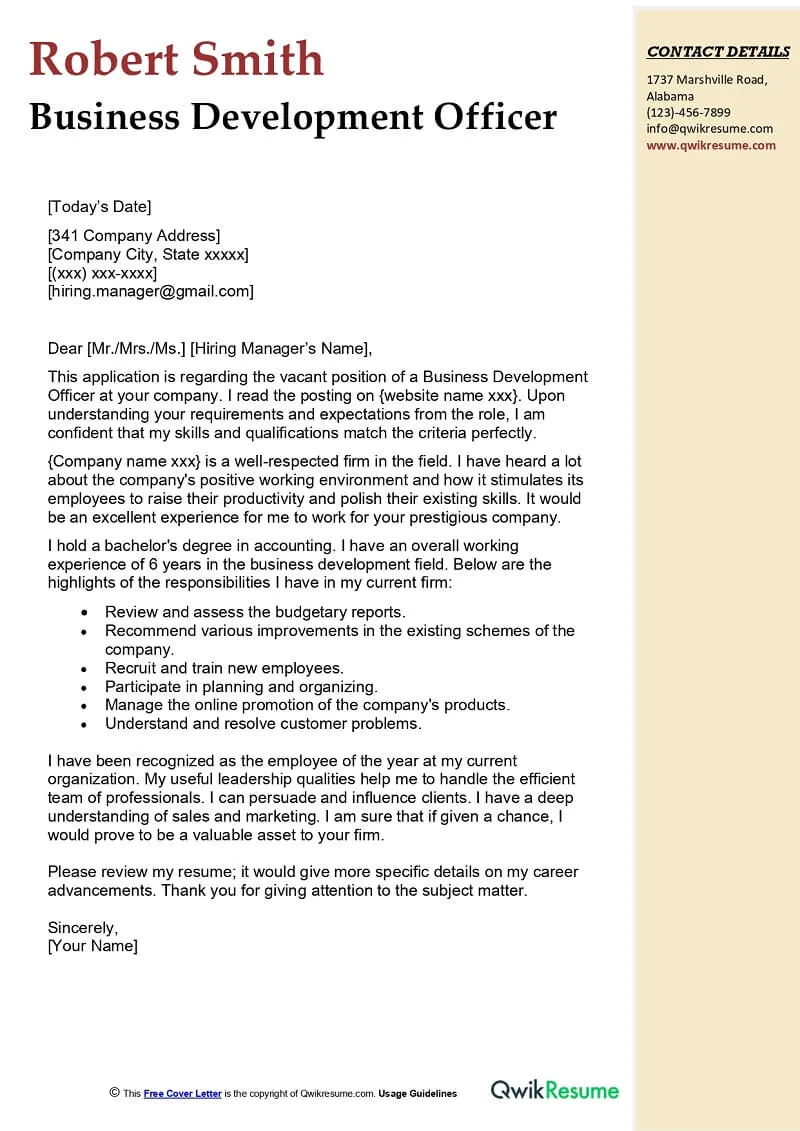
Formatting is crucial in making a professional cover letter. Keep your cover letter concise and easy to read. Use a professional font, such as Arial or Times New Roman, and maintain consistent font sizes. The text should be well-structured, using clear headings and subheadings to organize the information. Break up long paragraphs into shorter, more manageable sections. Use bullet points to highlight key accomplishments or skills. This will help the reader quickly grasp the most important information. Ensure the overall layout is clean and visually appealing. Properly formatted cover letters show that you can present information in a clear, organized, and professional manner. Use proper formatting, such as headers and spacing, to improve readability. If possible, tailor the formatting style to the company’s brand, if you are aware of it.
Key Elements of a Strong Cover Letter
A successful cover letter should include several key elements that communicate your value proposition. The opening paragraph should immediately grab the reader’s attention and state the position you are applying for. The body paragraphs should highlight your relevant experience, skills, and achievements. Provide concrete examples to support your claims, showing how you have succeeded in previous roles. Your closing paragraph should summarize your qualifications, restate your interest in the position, and include a call to action, such as requesting an interview. Do not forget to include your contact information at the top of your letter. A well-structured cover letter is crucial to make a positive first impression. Be sure to follow all application instructions and provide all required information. Ensure your contact details are current and professional.
The Opening Paragraph Grabbing Attention
The opening paragraph is critical as it sets the tone for the rest of your cover letter. Start with a strong statement that grabs the reader’s attention and clearly states the position you are applying for. Immediately express your enthusiasm for the role and the company. If you have a personal connection or referral, mention it here. Highlight your understanding of the company’s mission or values. Use an opening that aligns with the company’s culture, such as a brief anecdote or an intriguing question related to the job or the company. Make it clear why you are a suitable candidate and how your qualifications align with the job requirements. Your opening should be impactful and concise, showing you have a strong understanding of the role and are eager to contribute.
Middle Paragraphs Highlighting Experience and Skills
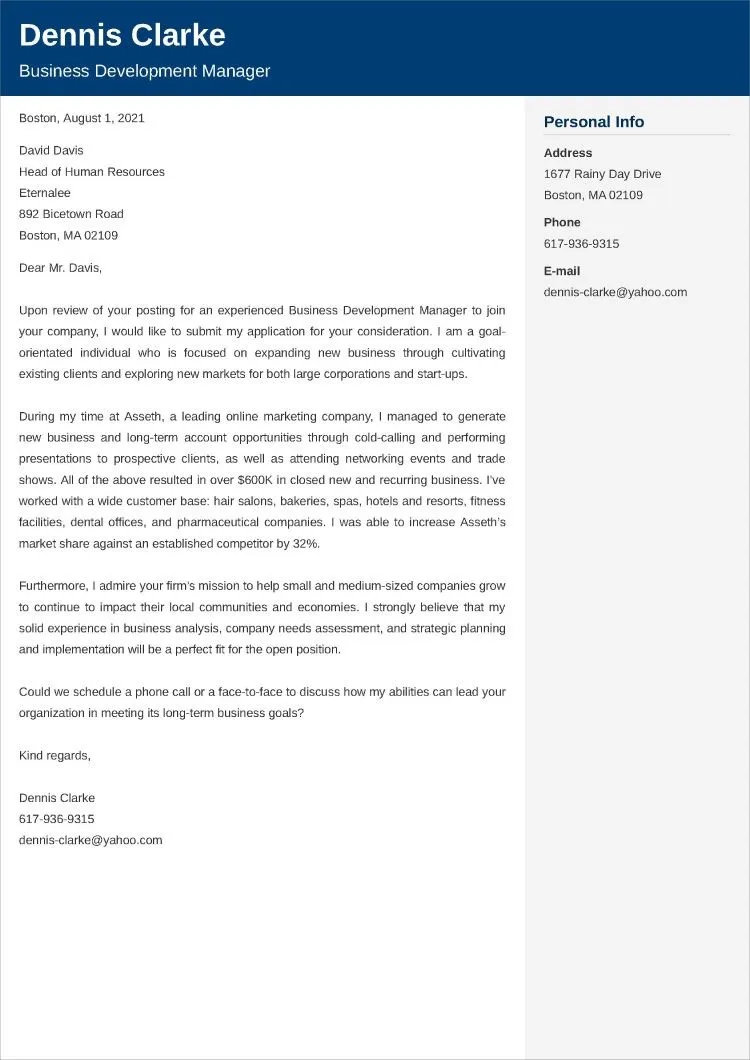
The middle paragraphs are where you provide detailed information about your experience and skills. Focus on the most relevant aspects of your career and highlight your accomplishments. Use the STAR method (Situation, Task, Action, Result) to describe your achievements and provide specific examples of your successes. Discuss the challenges you faced, the actions you took, and the positive outcomes you achieved. This method allows you to tell a compelling story that illustrates your abilities. Focus on those skills and experiences that are related to the job requirements. Quantify your accomplishments whenever possible, using numbers and data to demonstrate the impact of your contributions. Clearly explain how your skills and experience make you a good fit for the position. Your middle paragraphs should provide the hiring manager with a clear picture of your value and potential.
Closing Paragraph Call to Action
Your closing paragraph is your last opportunity to leave a lasting impression. Summarize your qualifications and reiterate your interest in the position. Reiterate your enthusiasm for the company and the opportunity to contribute. Include a clear call to action, such as requesting an interview or expressing your willingness to discuss your qualifications further. Thank the reader for their time and consideration. This shows courtesy and professionalism. Reiterate your contact information and make it easy for the hiring manager to reach you. End with a confident and positive tone, expressing your eagerness to move forward in the application process. A well-written closing paragraph will increase your chances of receiving an interview.
Proofreading and Editing Your Cover Letter
Before submitting your cover letter, meticulously proofread and edit it. Errors, such as typos, grammatical errors, and formatting inconsistencies, can damage your credibility and negatively impact your application. Always use spell-check and grammar-check tools, but do not rely on them entirely. Read your cover letter aloud to catch any awkward phrasing or sentence structure issues. Ask a friend or colleague to review your cover letter for clarity, accuracy, and overall impact. Make sure the language is clear and concise, avoiding jargon or overly complex sentences. Ensure your contact information is correct and that you have included all necessary attachments. A polished cover letter is essential, so you must invest time and effort into editing and proofreading it. A carefully proofread cover letter reflects professionalism and attention to detail.
Tools for Creating a Great Cover Letter
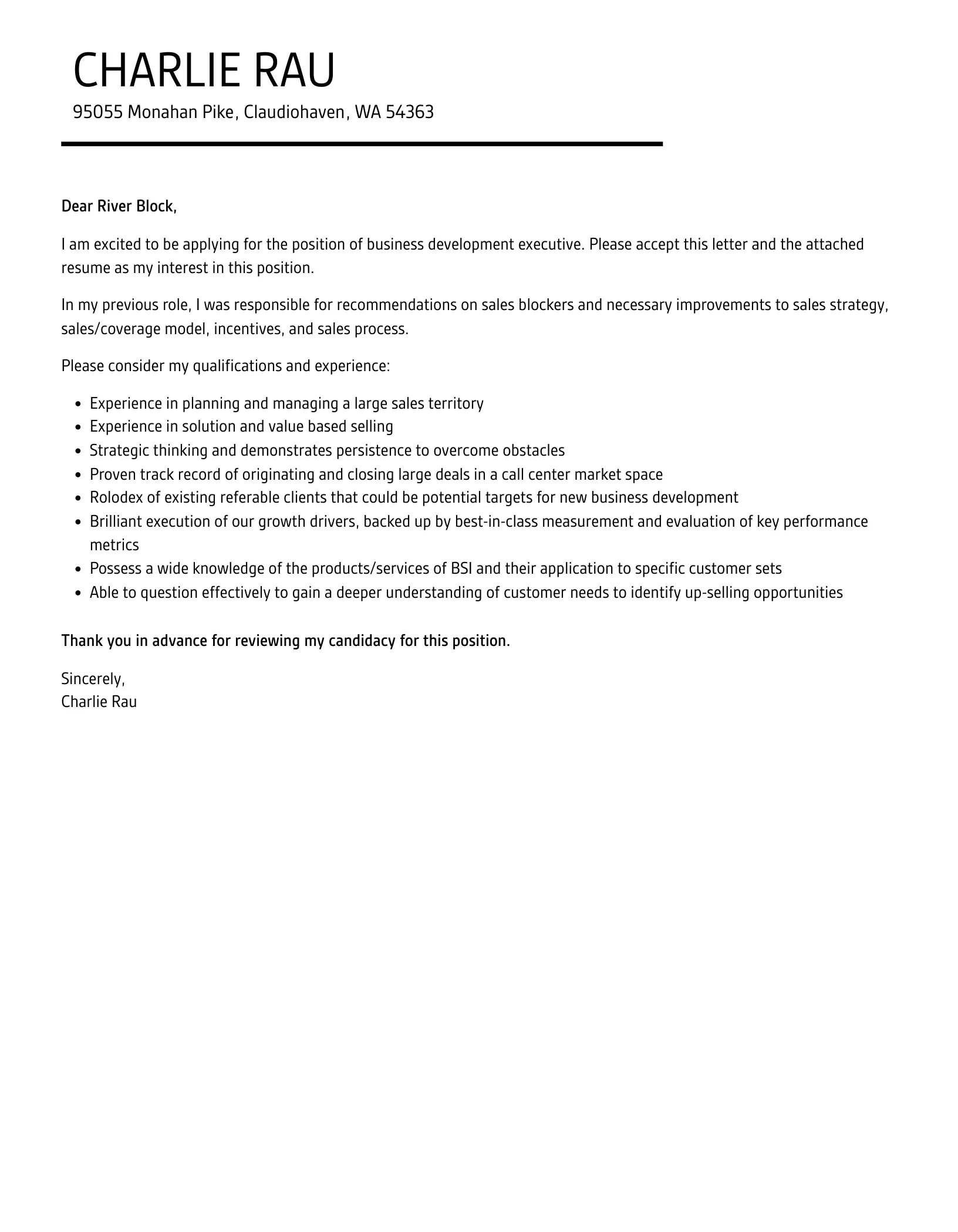
Multiple resources are available to assist you in writing a compelling cover letter. Utilize online cover letter templates as a starting point, but remember to tailor them to your specific needs. Explore cover letter examples that match the role and industry. These can provide inspiration and show you how to structure your letter. Use grammar-checking and spell-checking tools to avoid errors. Consider using AI-powered tools to analyze your cover letter for clarity, tone, and keyword optimization. Seek feedback from career counselors or mentors. This will provide insights and suggestions to improve your cover letter. By using these tools and resources, you can enhance your cover letter, making it more effective. With the right tools and guidance, you can create a cover letter that stands out.
